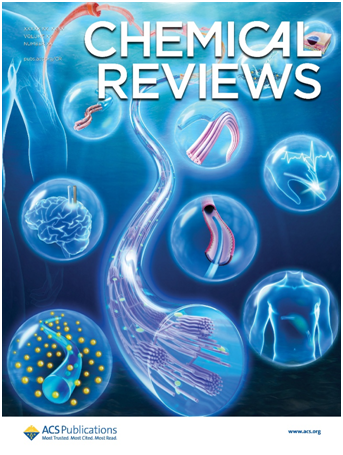Recently, Chemical Reviews published online a review article authored by the research team of Academician Zhu Meifang from the National Key Laboratory of Advanced Fiber Materials at College of Materials Science and Engineering, DHU. The paper, titled A Review of Hydrogel Fiber: Design, Synthesis, Applications, and Futures, was selected as the front cover story (Pic. 1) for the current issue. The study summarizes the development and research progress of hydrogel fibers, consolidating over a decade of exploration and technological expertise from Academician Zhu Meifang’s team in the formation and applications of Hydrogel fibers (HFs). Academician Zhu Meifang and Associate Researcher Hou Kai served as corresponding authors, while Associate Researcher Chen Guoyin was the first author. DHU was the sole corresponding institution.

Pic.1 The cover of the magazine
The term “hydrogel” was initially used to describe certain colloidal inorganic salts back to the late 19th and early 20th centuries. With advancements in the field, the meaning of hydrogel has evolved from its original definition and now primarily refers to a physically or chemically cross-linked polymer capable of swelling in water or biological fluids. Due to the unique structural and functional properties, HFs exhibit broad application potential in biomedical engineering, energy, environmental science, and other fields. Therefore, developing hydrogel fibers that can closely mimic biological functions is of great significance.
HFs are abundant in living organisms, including the three major tissues of the human body, that is, muscle, nerve, and connective tissue, which have the ability to transport materials and deliver energy, playing a crucial role in carrying out essential life functions through a collaborative bottom-up construction of function and structure. Therefore, the development of functional HFs that closely mimic biofunction ability is highly desirable. HFs are characterized by their high-water content and have a fibrous shape with a cross-linking network in condensed structures. They combine the functional characteristics of hydrogel materials (soft, wet, environmentally, responsive, biocompatible) with the structural advantages of fiber materials (high aspect ratio, anisotropy, flexibility). Therefore, a systematic understanding of the development and current challenges of HFs is of great significance for their functionalization and structural construction, potentially leading to the realization of bionic functions similar to those found in the human body. This paper discussing the development of HFs, focusing on material composition, structural design, functional construction, and applications, while also addressing the limitations and challenges associated with HFs in detail. The goal of this review is to provide guidelines for the construction of functional or bionic HFs and their practical applications.

Pic.2 Schematic overview of the HFs from design, synthesis to applications

Pic.3 Development of the HFs in the past decades

Pic.4 Structural design of HFs for high-performance fabrication
Read the full paper: https://pubs.acs.org/doi/10.1021/acs.chemrev.5c00159


